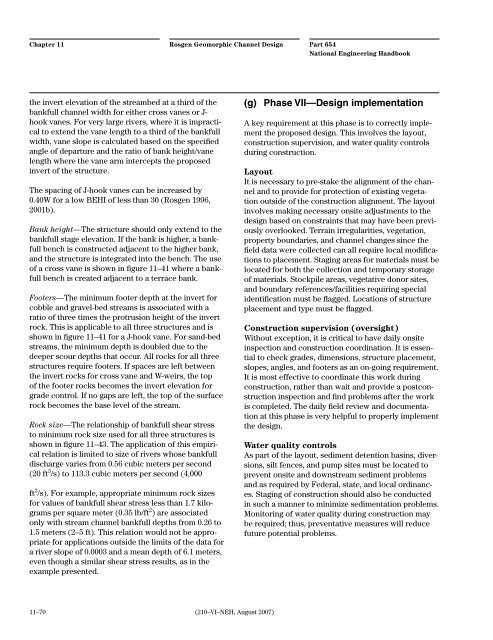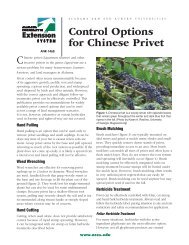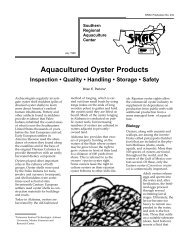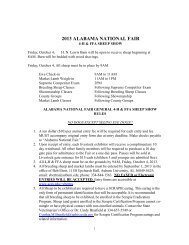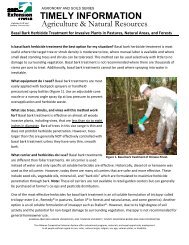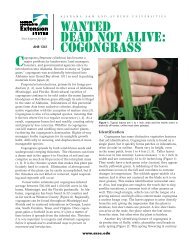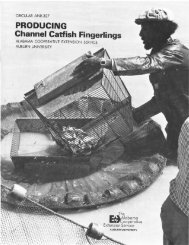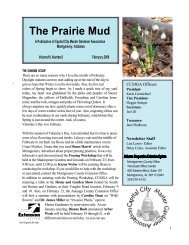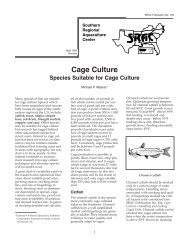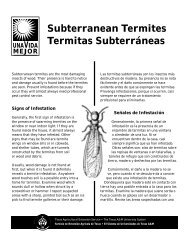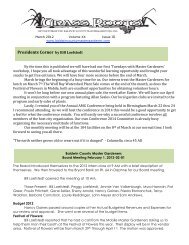Chapter 11--Rosgen Geomorphic Channel Design
Chapter 11--Rosgen Geomorphic Channel Design
Chapter 11--Rosgen Geomorphic Channel Design
Create successful ePaper yourself
Turn your PDF publications into a flip-book with our unique Google optimized e-Paper software.
<strong>Chapter</strong> <strong>11</strong><br />
the invert elevation of the streambed at a third of the<br />
bankfull channel width for either cross vanes or Jhook<br />
vanes. For very large rivers, where it is impractical<br />
to extend the vane length to a third of the bankfull<br />
width, vane slope is calculated based on the specified<br />
angle of departure and the ratio of bank height/vane<br />
length where the vane arm intercepts the proposed<br />
invert of the structure.<br />
The spacing of J-hook vanes can be increased by<br />
0.40W for a low BEHI of less than 30 (<strong>Rosgen</strong> 1996,<br />
2001b).<br />
Bank height—The structure should only extend to the<br />
bankfull stage elevation. If the bank is higher, a bankfull<br />
bench is constructed adjacent to the higher bank,<br />
and the structure is integrated into the bench. The use<br />
of a cross vane is shown in figure <strong>11</strong>–41 where a bankfull<br />
bench is created adjacent to a terrace bank.<br />
Footers—The minimum footer depth at the invert for<br />
cobble and gravel-bed streams is associated with a<br />
ratio of three times the protrusion height of the invert<br />
rock. This is applicable to all three structures and is<br />
shown in figure <strong>11</strong>–41 for a J-hook vane. For sand-bed<br />
streams, the minimum depth is doubled due to the<br />
deeper scour depths that occur. All rocks for all three<br />
structures require footers. If spaces are left between<br />
the invert rocks for cross vane and W-weirs, the top<br />
of the footer rocks becomes the invert elevation for<br />
grade control. If no gaps are left, the top of the surface<br />
rock becomes the base level of the stream.<br />
Rock size—The relationship of bankfull shear stress<br />
to minimum rock size used for all three structures is<br />
shown in figure <strong>11</strong>–43. The application of this empirical<br />
relation is limited to size of rivers whose bankfull<br />
discharge varies from 0.56 cubic meters per second<br />
(20 ft 3 /s) to <strong>11</strong>3.3 cubic meters per second (4,000<br />
ft 3 /s). For example, appropriate minimum rock sizes<br />
for values of bankfull shear stress less than 1.7 kilograms<br />
per square meter (0.35 lb/ft 2 ) are associated<br />
only with stream channel bankfull depths from 0.26 to<br />
1.5 meters (2–5 ft). This relation would not be appropriate<br />
for applications outside the limits of the data for<br />
a river slope of 0.0003 and a mean depth of 6.1 meters,<br />
even though a similar shear stress results, as in the<br />
example presented.<br />
<strong>Rosgen</strong> <strong>Geomorphic</strong> <strong>Channel</strong> <strong>Design</strong><br />
<strong>11</strong>–70 (210–VI–NEH, August 2007)<br />
Part 654<br />
National Engineering Handbook<br />
(g) Phase VII—<strong>Design</strong> implementation<br />
A key requirement at this phase is to correctly implement<br />
the proposed design. This involves the layout,<br />
construction supervision, and water quality controls<br />
during construction.<br />
Layout<br />
It is necessary to pre-stake the alignment of the channel<br />
and to provide for protection of existing vegetation<br />
outside of the construction alignment. The layout<br />
involves making necessary onsite adjustments to the<br />
design based on constraints that may have been previously<br />
overlooked. Terrain irregularities, vegetation,<br />
property boundaries, and channel changes since the<br />
field data were collected can all require local modifications<br />
to placement. Staging areas for materials must be<br />
located for both the collection and temporary storage<br />
of materials. Stockpile areas, vegetative donor sites,<br />
and boundary references/facilities requiring special<br />
identification must be flagged. Locations of structure<br />
placement and type must be flagged.<br />
Construction supervision (oversight)<br />
Without exception, it is critical to have daily onsite<br />
inspection and construction coordination. It is essential<br />
to check grades, dimensions, structure placement,<br />
slopes, angles, and footers as an on-going requirement.<br />
It is most effective to coordinate this work during<br />
construction, rather than wait and provide a postconstruction<br />
inspection and find problems after the work<br />
is completed. The daily field review and documentation<br />
at this phase is very helpful to properly implement<br />
the design.<br />
Water quality controls<br />
As part of the layout, sediment detention basins, diversions,<br />
silt fences, and pump sites must be located to<br />
prevent onsite and downstream sediment problems<br />
and as required by Federal, state, and local ordinances.<br />
Staging of construction should also be conducted<br />
in such a manner to minimize sedimentation problems.<br />
Monitoring of water quality during construction may<br />
be required; thus, preventative measures will reduce<br />
future potential problems.


